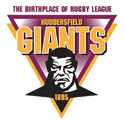Huddersfield Giants
 From Conservapedia
From Conservapedia 
Huddersfield Giants[1] are an English rugby league club based in the town of Huddersfield, West Yorkshire. They are current members of the professional top-flight European competition, the Engage Super League.[2]
Contents
- 1 History
- 2 Honors
- 2.1 Challenge Cup Winners
- 2.2 Super League[4]
- 2.3 National League Winners
- 2.4 Yorkshire Cup (Rugby Union)
- 2.5 Yorkshire Cup (Rugby League)
- 2.6 Yorkshire League
- 3 Notes & references
History[edit]
The rugby club grew out of Huddersfield Athletics and Cricket Club and played for about 30 years as part of the English Rugby Union. In 1895 they joined the Northern Rugby Football Union, which became what is now known as the Rugby Football League.[3]
Huddersfield's golden age was in the early part of the 19th century when they became the dominant force in English rugby. The became known as "The Team of All Talents" and they won 13 trophies in the five years leading up to World War I becoming only the second team to achieve "All Four Cups" by winning the Championship, the Challenge Cup, the Yorkshire Cup, and the Yorkshire League in 1914-15. After the war the club were moderately successful but never reclaimed their previous level. During the 1970s the club reached a low with the stadium falling into disrepair and the club often finishiing in the nether regions of the league. Following a takeover by a local businessman in 1984, the club was renamed Huddersfield Barracudas but this was dropped in 1988.
With the arrival of a new coach (Alex Murphy) in 1991 the club started to progress and were the first ever champions of the new third division in 1991/2. Steady progress saw Huddersfield being promoted to Super League in 1998 but in late 1999 they merged with Sheffield Eagles for financial reasons and became known as the Huddersfield-Sheffield Giants. This arrangement lasted only a season before the Huddersfield name was reverted to.
The Giant's current home ground is the Galpharm Stadium (formerly the Alfred McAlpine Stadium) in Huddersfield which they share with Huddersfield Town A.F.C. (soccer club). It was built in 1994 and has a capacity of 25,000. The club's current sponsor is the University of Huddersfield. Although Huddersfield are now known as the Giants, they have also been known as the Fartowners after the ground in the Fartown district of the town which they used from 1878 until 1994. The club strip comprises a claret-colored shirt with thin gold hoops, claret shorts, and claret and gold hooped socks.
Honors[edit]
Challenge Cup Winners[edit]
- 1912-13
- 1914-15
- 1919-20
- 1932-33
- 1944-45
- 1952-53
Super League[4][edit]
- Best position: 5th (2007)
National League Winners[edit]
- 1911-12
- 1912-13
- 1914-15
- 1928-29
- 1929-30
- 1948-49
- 1961-62
Yorkshire Cup (Rugby Union)[edit]
- 1889-90
Yorkshire Cup (Rugby League)[edit]
- 1909-10
- 1911-12
- 1913-14
- 1914-15
- 1918-19
- 1919-20
- 1926-27
- 1931-32
- 1938-39
- 1950-51
- 1952-53
- 1957-58
Yorkshire League[edit]
- 1911-12
- 1912-13
- 1913-4
- 1914-15
- 1919-20
- 1921-22
- 1928-29
- 1929-30
- 1948-49
- 1949-50
- 1951-52
Notes & references[edit]
- ↑ Official club site
- ↑ Super League official web site
- ↑ Rugby Football League official site
- ↑ Super League statistics
| |||||
↧ Download as ZWI file | Last modified: 02/25/2023 03:41:56 | 65 views
☰ Source: https://www.conservapedia.com/Huddersfield_Giants | License: CC BY-SA 3.0
 ZWI signed:
ZWI signed: KSF
KSF